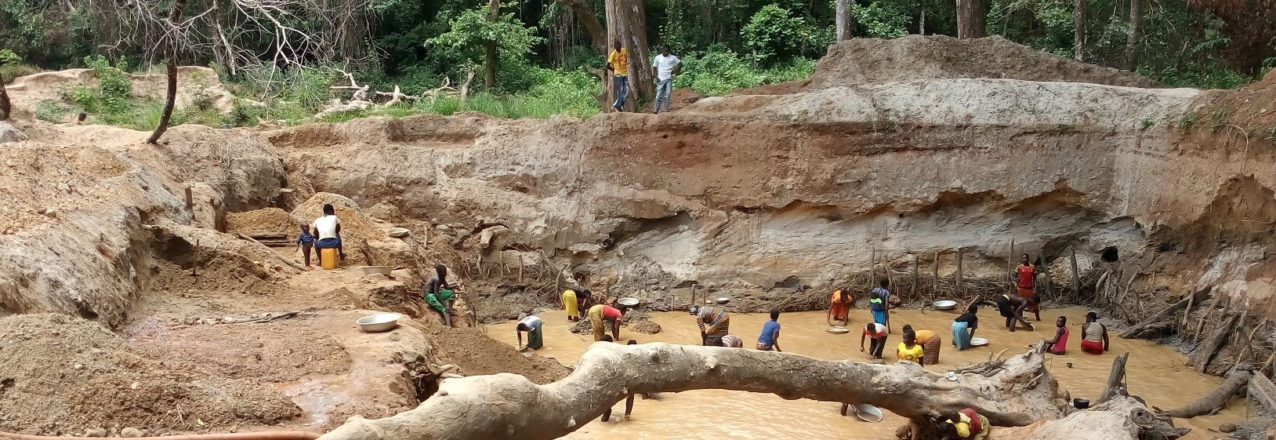This quarterly performance report describes achievements realized under USAID’s Artisanal Mining and Property Rights Project (USAID AMPR) in the Central African Republic (CAR) between October 1 and December 31, 2019.
In general, the USAID AMPR project is on solid footing after a year spent in setting up the national and three regional offices while also meeting all complex host-country registration and labor law compliance requirements. By the end of the year, nearly all in-country staff had been hired and placed on long-term contracts. Guided by the Year I Work Plan, the project met nearly all deliverables on time. While Year I activities may be viewed as setting the programmatic foundations for subsequent years through background applied research and consultation with stakeholders, the USAID AMPR team made significant advancements on many programmatic issues summarized below.
Objective 1: Assist Government of the Central African Republic to Improve Compliance with Kimberley Process Requirements to Promote Licit Economic Activities
- Draft road map completed for strengthening diamond supply chain governance, including regulatory and institutional changes.
- Technical support provided for revision of the decree for the CAR Kimberley Process National Monitoring Committee (CNS PK). Revised decree signed by Minister of Mines and Geology in November. Action plan now in place for USAID AMPR support to the CNS PK.
- Field mission carried out in Carnot and Nola sub-prefectures to judge community interest in artisanal mining zones (Zones d’exploitation artisinal, or ZEAs) with exchanges providing the basis for preparing a plan for the pilot ZEA implementation phase in the next quarter.
- Field mission and trainings successfully carried out by the nongovernmental organization INDIGO on how to prepare “capsule” videos to promote social dialogue. Subcontractor Société Elie Numérique worked with the INDIGO consultant to document the trainings that will form part of the content of five short videos that USAID AMPR plans to produce in the coming work plan year.
- Inter-donor coordination structure set up with complementary programming now occurring between USAID, World Bank, and European Union projects providing support to the Ministry of Mines and Geology (MMG).
Objective 2: Strengthen Community Resilience, Social Cohesion, and Responses to Violent Conflict in the Central African Republic
- 11 peace-building committees (Comités Locales de Paix et de la Réconciliation, or CLPRs) prepared for official recognition, but ceremonies were delayed because of heavy flooding in Bangui that required emergency government humanitarian responses.
- CLPR peace-building activities in Carnot unfolded supporting the reintegration of refugees returning from Kentzou, Cameroon, with the support of the Ministry of Humanitarian Action and National Reconciliation (MHANR) and United Nations High Commissioner for Refugees.
- Preparations advanced for applied field research and public consultations on the root causes of armed pastoralism in the southwest leading to an action plan for multi-stakeholder interest groups.
- Procurement completed with the nongovernmental organization Women Action for the Promotion of Entrepreneurship for a two-year subcontract to implement agricultural and organizational support to women’s groups.
- Pisciculture fish farming assessment carried out jointly by the European Union Renforcement de la Gouvernance dans les Secteurs de l’Extraction Artisanale du Diamant et de l’Or en République Centrafricaine (GODICA) project and USAID AMPR completed for 413 fishponds in the project’s operational zones of Nola, Carnot, and Boda. Promising results suggested continued support for this income-generating activity could equal the value of diamond mining efforts.
Objective 3: Increase Awareness and Understanding of the Opportunities and Challenges of Establishing Responsible Gold Supply Chains in the Central African Republic
- Artisanal gold diagnostic report drafted and online interactive web map disseminated internally by subcontractor International Peace Information Service (IPIS) to summarize situation around 322 mine sites employing approximately 62,000 artisanal miners.
- Technical and administrative preparations finalized for restitution of gold mining diagnostic workshop by IPIS and Code of Risk Mitigation for Artisanal and Small-Scale Miners Engaging in Formal Trade (CRAFT) training by USAID AMPR subcontractor RESOLVE in early January.
Objective 4: Improve USAID Programming through Increased Understanding of Linkages Between Artisanal and Small-Scale Mining and Key Development Issues
- Discussions completed with USAID and Levin Sources, Artisanal Pathways, and the Tetra Tech home office to finalize the technical scope and contract for the Responsible Artisanal Diamond Sourcing initiative expected to be launched in the next quarter.
- Component 4 Coordinator attended the Kimberley Process Plenary held in November in New Delhi, India, leading to the successful adoption by the Kimberley Process of limited changes to the Operational Framework. Most significant change was switching to a “notification” system whereby Government of CAR (GoCAR) can authorize exports from compliant zones at will rather than first requiring pre-authorization from the CAR Monitoring Team. General update on USAID AMPR activities provided to the Working Group on Alluvial and Artisanal Production.
- Component 4 Coordinator attended a two-day workshop organized by the Organization of Economic Cooperation and Development and European Union in Brussels on minerals-related crimes. The coordinator organized and facilitated a panel on the situation in CAR in collaboration with the European Union GODICA project’s Technical Advisor, IPIS, and the United Nations Panel of Experts Coordinator.
This quarterly report presents descriptions and results of each activity in USAID AMPR’s approved Annual Work Plan for the period of October through December 2019.


